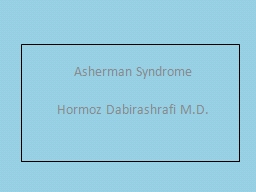

Heinrich Fritsch 1927 Stamen 1946 1948 Joseph GAshenman The focus of research in the initial Prevalence E tiology and Pathology The focus of research has now Diagnosis Treatment and Reproductive Outcomes ID: 1032035
Download Presentation The PPT/PDF document "Asherman Syndrome Hormoz Dabirashrafi M..." is the property of its rightful owner. Permission is granted to download and print the materials on this web site for personal, non-commercial use only, and to display it on your personal computer provided you do not modify the materials and that you retain all copyright notices contained in the materials. By downloading content from our website, you accept the terms of this agreement.
1. Asherman SyndromeHormoz Dabirashrafi M.D.
2. Heinrich Fritsch (1927) Stamen (1946)1948 (Joseph G.Ashenman)The focus of research in the initial:Prevalence, Etiology and PathologyThe focus of research has now:Diagnosis, Treatment and Reproductive Outcomes
3. DefinitionAsherman.Sy: curettage of the gravid uterusSyndrome: a group of symptoms…Asymptomatic intrauterine adhesionsIntrauterine fibrosis
4. PrevalenceIsrael, Greece, South America1- Degree of awareness2- The number of therapeutic or illegal – ab 3- Sharp, blunt or suction curettage…4- Incidence of G.Tub5- Criteria Used for diagnosis of…
5. EtiologyA- Truma:1- Truma to a gravid uterine cavity 66.7% post abortion /miscarriage curettage – 21.5% postpartum curettage 2% after CS - 0.6% after mole…Explanation: a) low estrogen statusb) The uterus could be in a vulnerable state 2- Truma to non-gravid uterus Diagnostic curettage (1.6%) – abdominal myomectomy (1.3%)Cervical biopsy or Polypectomy (0.5%) - UseOf radium (0.02%) - Insertion of IUD (0.2%)
6. B- Post Hysteroscopy6.7% resection of septa 31.3% resection of solitary fibroid and multiple fibromas.A case of adhesion after UAE.After endometrial ablation (with thermal balloon) 36.4%
7. C- Infection:Uterine truma and subsequent inflammation in conjunction with a low estrogen status may potentially lead to fibrosis. 1856 case – 74 case TB D- Congenital anomaly of the uterus 43 malformations 7 had Ashenman.Synd (16%)E- Genetic predisposition:Gentle suction curettageNo apparent reason
8. SymptomatologyAtretic amenorrhea. 43% infertility (lack of sufficient amount of normal end – defective vascularization). spontaneous miscarriage 40%, preterm-d 23%, placenta accrete 13%, ectopic p 12%, IUGR.No limb amputation
9. Endometrial Ablation70 pregnancies:1.4% EP - 21% Spontaneous miscarriage. 18.6% premature D 4%IUGR - adherent placenta 14.3%- A case of fetal malformations(limbs abnormality, Scoliosis….)Endometrial malignancyAsherman.Sy and end adenocarcinoma can exist simultaneously….
10. InvestigationsHSG: Prospective study: HSG was comparable with Hysteroscopy It remains an important screening procedureLimitations: not detect end fibrosis –limitation in defining the nature of identified intrauterine adhesions-minor filmy adhesions- air bubbles- differential diagnosis
11. Ultrasonography: Uterine cavity (not possible by HSG or hysteroscopy)Sensitivity and specificity is low Ultrasonography before hysteroscopy SonohysterographyAs accurate as HSG – The sensitivity of SHG 100% - HSG 100% - TVS=52%MRISupplementary role cannot visualize by hysteroscopy
12. TreatmentRestoring the size and shape –preventing recurrence-promoting the repair-restoring normal reproductive functions1)Expectant management (23-18 regular mense)292-133 conserved spontaneously 2) Blind D&C, high incidence of uterine perforation +low success3) Hysterotomy nowadays –very severe cases.3 cases-most extreme of situations
13. 4) Hysteroscopy Adhesiolysis:Method of choice (minimally invasive under vision)Scissors, Unipolar, Bipolar, LaserNo diff in outcome between Scissors, resectoscope and laser. Guide: laparoscopy (often too late…) fluoroscopy, Gynecoradiologic uterine resection, Transabdominal ultrasound.laminaria tent. Sonohysterography.Conversion to septum division-repeat surgery.Genital TBTotal uterine synechia – poor prognosis –surrogacy.
14. ComplicationPerforation, Hemorrhage, Pelvic infection
15. Prevention of recurrence (1.3% - 23.5%)1) IUD (the loop IUD the best choice)No randomized study?2) Foley balloon catheter Foley cath (for 10 days) safer, more effective than IUD (3 month)Prospective controlled study (balloon & no splint)Stem not coming out of the cervix3.5 c.c very important 3) Amnion graft 4) Hyaluronic acid (very effective)Seprafilm - auto – cross – linked HA (ACP)
16. 5)Hormone Treatment: No objective evidence, on the reduction of reformation of adhesion.
17. Prevention1) Curettage in the postpartum or post abortion period should be avoided – hysteroscopy 2) Perform gentle curettage (suction or blunt curette)3) Select medical management
18. Conclusion- The management of moderate to severe Disease still poses a challenge, and the prognosis of severe disease remains poor- repeat surgery may be necessary without desired out come- In pregnancy after treatment, careful surveillance…-future research: cellular and molecular aspects of endometrial tissue regeneration, prevention of postsurgical adhesion formation
19. END